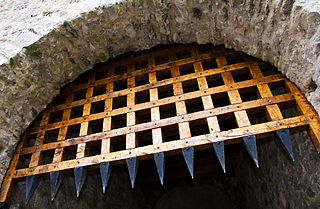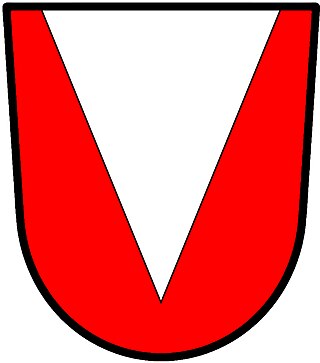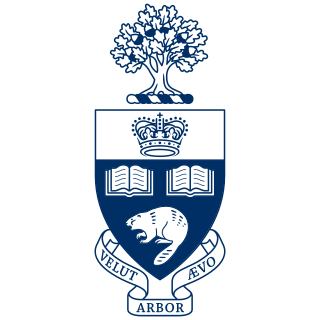
The coat of arms of Canada, also known as the Royal Coat of Arms of Canada or, formally, as the Arms of His Majesty The King in Right of Canada, is the arms of dominion of the Canadian monarch and, thus, also the official coat of arms of Canada. In use since 1921, it is closely modelled after the royal coat of arms of the United Kingdom, with French and distinctive Canadian elements replacing or added to those derived from the British version.

The coat of arms of the state of New York was formally adopted in 1778, and appears as a component of the state's flag and seal.

A portcullis is a heavy, vertically closing gate typically found in medieval fortifications, consisting of a latticed grille made of wood and/or metal, which slides down grooves inset within each jamb of the gateway.

The coat of arms of Prince Edward Island, officially the King's Arms in Right of Prince Edward Island, are the coat of arms of Prince Edward Island, being the arms of King Charles III in right of the province. They were created when the shield and motto in the achievement were granted in 1905 by royal warrant from King Edward VII. The latest iteration was given by the Canadian Heraldic Authority in 2002.

The coat of arms of Nunavut was granted by a warrant of Roméo LeBlanc, Governor General of Canada, dated 31 March 1999, one day before the territory of Nunavut, Canada, was created. The same document specified the flag of Nunavut.

The provincial flag of Saskatchewan was adopted in 1969. It is blazoned per fess vert and or, in the fly a prairie lily slipped and leaved proper, in the dexter chief an escutcheon of the coat of arms of Saskatchewan fimbriated argent. The symbolism within the flag is shown just with the colours; yellow representing the grain fields in the southern portion of the province where as the green represents the northern forested areas. The western red lily in the fly of the flag is the provincial flower. In 2017, The Minister of Parks, Culture and Sports designated September 22 as Saskatchewan Flag Day.
In heraldry, an ordinary is one of the two main types of charges, beside the mobile charges. An ordinary is a simple geometrical figure, bounded by straight lines and running from side to side or top to bottom of the shield. There are also some geometric charges known as subordinaries, which have been given lesser status by some heraldic writers, though most have been in use as long as the traditional ordinaries. Diminutives of ordinaries and some subordinaries are charges of the same shape, though thinner. Most of the ordinaries are theoretically said to occupy one-third of the shield; but this is rarely observed in practice, except when the ordinary is the only charge.

The coat of arms of Toronto is a heraldic symbol used to represent the city Toronto. Designed by Robert Watt, the Chief Herald of Canada at the time, for the City of Toronto after its amalgamation in 1998. The arms were granted by the Canadian Heraldic Authority on 11 January 1999.

The Council of the Royal County of Berkshire, also known as the Berkshire County Council, was the top-tier local government administrative body for Berkshire from 1889 to 1998. The local authority had responsibilities for education, social services, public transport, planning, emergency services and waste disposal, and had 87 members. Berkshire County Council shared power with six lower-tier district councils, each of which directed local matters.

The coat of arms of Sunderland is the official heraldic arms of the City of Sunderland in England.

The coat of arms of Denmark has a lesser and a greater version.

The Royal Montreal Regiment is a Primary Reserve infantry regiment of the Canadian Army based in Westmount, Quebec. It is part of the 2nd Canadian Division's 34 Canadian Brigade Group.

The coat of arms of the Government of Northern Ireland was granted to the Executive Committee of the Privy Council of Northern Ireland in 1924.

The coat of arms of the Republic of Seychelles shows a shield, in which a giant tortoise is located on green grounds. On the ground there is a coco de mer palm tree. Behind it there is a blue sea with two islands and a sail ship to be seen. The shield is enthroned by a silver helmet, on which a white-tailed tropicbird is located above blue and white waves. The shield is supported by two white sailfish. Beneath the shield the motto of Seychelles is stated: "Finis Coronat Opus".

The Coat of arms of Penang is largely based on the coat of arms of Penang first granted to the Settlement of Penang, then in the Federation of Malaya, by a Royal Warrant of King George VI dated 11 September 1949.

In heraldry, a pile is a charge usually counted as one of the ordinaries. It consists of a wedge emerging from the upper edge of the shield and converging to a point near the base. If it touches the base, it is blazoned throughout.

The coat of arms of King's College London in London, England, are blazoned: on a Pale Azure between two Lions rampant respectant Gules an Anchor Gold ensigned by a Royal Crown proper on a Chief Argent an Ancient Lamp proper inflamed Gold between two Blazing Hearths also proper.

The coat of arms of the University of Toronto is the primary emblem of the University of Toronto, which is the largest university in Canada. It is currently used in several different contexts by the University and can be seen on its own, on the University banner, as part of the heraldic achievement of the University, or featured in the logos of numerous University divisions, as well as the logo of the University as a whole.

The coat of arms of the University of Sheffield is the official heraldic emblem of the University of Sheffield. It was granted by the College of Arms on 28 June 1905, one month after the university's royal charter was sealed. The coat of arms was registered as a trademark by the University of Sheffield in 1992. In 2005, the university designed a logo consisting of a simplified version of the arms; the logo, however, does not supersede the heraldic symbol.

The flag of Regina is the banner representing the city of Regina. The flag is composed of a horizontal bicolour of yellow and blue accompanied by a crown in top left corner. It was presented to the city on September 14, 1992, by the Governor General at the time. Prior to 1992, it was purple. That flag had a royal connection reflecting the city's royal roots. However, the flag was unofficial.



















